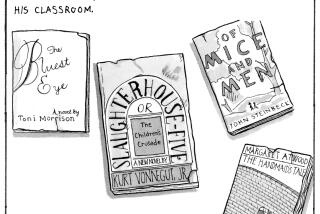Discoveries: ‘Stieg Larsson’ by Kurdo Baksi
Stieg Larsson
Our Days in Stockholm: A Memoir of a Friendship
Kurdo Baksi, translated from the Swedish by Laurie Thompson
Pegasus Books: 144 pp., $22
What does a writer leave behind? Unfinished work, clues about the creation of his characters, experiences that worked their way into his writing. And, like everyone else, relationships. Kurdo Baksi met Stieg Larsson (author of the trilogy that begins with “The Girl With the Dragon Tattoo”) in 1992. Larsson was 38 and editor of the leftist magazine Expo. Baksi was 27, editor of another anti-racist magazine, Svartvitt. Larsson had just published his first book, “The Extreme Right,” on organized racism. (He would write other books on racism, misogyny and neo-Nazism.) From that meeting on, the two saw each other almost every day (in 1998 they merged the two magazines) until Larsson’s sudden death in 2004. The two supported each other through crises, including death threats.
Baksi does a little research on his friend’s background, but this is the story of a friendship. Baksi writes that Larsson lived for his work as a journalist and activist. He had insomnia, was stunningly productive, had terrible eating habits and was haunted by certain memories that, in many ways, fueled his writing.
When Larsson was 15, he watched three friends rape a 15-year-old girl. He did nothing to stop them and, haunted by her screams, went to apologize a few days later. She refused to accept it. Baksi feels that Larsson has more in common with his character Lisbeth Salander than with Mikael Blomkvist. He believes that Salander is based in part on a young researcher at Expo whose arrest for domestic abuse was much publicized. Baksi is still amazed by his friend’s ability to write the novels in relative secrecy. In 2003 Larsson brought the completed books to a publisher who turned him down; the next publisher accepted all three.
Aaaaw to Zzzzzd
The Words of Birds: North America, Britain and Northern Europe
John Bevis
The MIT Press: 144 pp., $12.95
“They are the childhood we never had, the life in which we meet each little threat, each little discomfort, by flapping our arms, calling ‘Cheerio!’ and flashing out of sight, away, forever.” This gorgeous little book is a lexicon of bird words, the most plausible notation of sounds that often have dozens of phonic interpretations. “Aaaaw” is the sound a black skimmer makes, “zzzzzd,” the call of a lazuli bunting. I particularly love the section on mnemonics, phrases that “catch the rhythm and emphasis” of a bird’s song in words and phrases, such as the great horned owl’s “are you awake? me too,” or the skylark’s “whither I flee, whither o whither I flee.”
John Bevis begins in his Shropshire garden near the River Severn and takes flight. This book is filled with enigmatic black-and-white photos of cottage gardens, fields and hedgerows and is reminiscent of the work of the famous wanderer W.G. Sebald. Bevis muses on the appeal of birds, which “help to define and distinguish one piece of land from another.” Alluring in their appearance and marvelous in their movements, they are a metaphor for freedom and have “an intensity that we ourselves no longer possess.” They are “buoyed by dawn and by spring, bored by afternoon and summer, wistful at evening and in autumn.” This book is an elegant tribute to the beauty of its subject.
My Reading Life
Pat Conroy
Nan A. Talese / Doubleday: 340 pp., $25
It began with his mother, who promised that books would make him smart. Each new discovery in nature inspired her to get him a library book. His father thought reading was showing off: “He would take me by the throat … lift me off my feet, strangle me and beat my head against the wall.” Pat Conroy would write about his father, a child and wife beater, in “The Great Santini.” “I felt like I had put a gun to my family’s head and pulled the trigger,” he writes here of the fallout of that novel.
Madame Bovary, Jay Gatsby — Conroy shows how these and other characters have lived inside him. He remembers his mother reading “Gone With the Wind” to him when he was 5 and for years after. He recognized the South he grew up in — his mother modeled herself on Scarlett O’Hara. English teachers, librarians, Count Tolstoy: These are Conroy’s happy ghosts and guardian angels. “I grew up a word-haunted boy.” Literature, he writes, taught him how to be a man.
Salter Reynolds is a writer in Los Angeles.
More to Read
The biggest entertainment stories
Get our big stories about Hollywood, film, television, music, arts, culture and more right in your inbox as soon as they publish.
You may occasionally receive promotional content from the Los Angeles Times.






